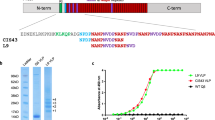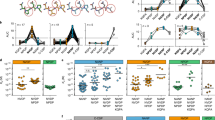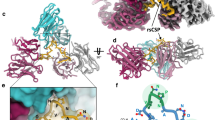Abstract
An ideal vaccine should elicit a long lasting immune response against the natural parasite, both at the T- and B-cell level. The immune response should occur in all individuals and be directed against determinants that do not vary in the natural parasite population. A major problem in designing synthetic peptide vaccines is that T cells generally recognize peptide antigens only in association with one or a few of the many variants of major histocompatibility complex (MHC) antigens1,2. During the characterization of epitopes of the malaria parasite Plasmodium falciparum that are recognized by human T cells, we analysed a sequence of the circumsporozoite protein, and found that synthetic peptides corresponding to this sequence are recognized by T cells in association with many different MHC class II molecules, both in mouse and in man. This region of the circumsporozoite protein is invariant in different parasite isolates3,4. Peptides derived from this region should be capable of inducing T-cell responses in individuals of most HLA-DR types, and may represent good candidates for inclusion in an effective anti-malaria peptide vaccine.
This is a preview of subscription content, access via your institution
Access options
Subscribe to this journal
Receive 51 print issues and online access
$199.00 per year
only $3.90 per issue
Buy this article
- Purchase on Springer Link
- Instant access to full article PDF
Prices may be subject to local taxes which are calculated during checkout
Similar content being viewed by others
References
Benacerraf, B. & Germain, R. N. Immunol. Rev. 38, 70–119 (1978).
Buus, S., Sette, A., Colon, S., Miles, C. & Grey, H. M. Science 235, 1353–1358 (1987).
Del Portillo, H. A., Nussenzweig, R. S. & Enea, V. Molec. Biochem. Parasitol. 24, 289–294 (1987).
De la Cruz, V. F., Lal, A. A. & McCutchan, T. F. J. biol. Chem. 262, 11935–11939 (1987).
Sinigaglia, F. et al. Eur. J. Immunol. 18, 633–636 (1988).
Trucco, M. M., Garotta, G., Stocker, J. W. & Ceppellini, R. Immunol. Rev. 47, 219–252 (1979).
Watson, A. M., DeMars, R., Trowbridge, I. S. & Bach, F. H. Nature 304, 358–361 (1983).
Ziegler, A. & Milstein, C. Nature 279, 243–244 (1979).
Schwartz, R. H. A. Rev. Immunol. 3, 237–261 (1986).
Shastri, N., Gammon, G., Miller A. & Sercarz, E. E. J. exp. Med. 164, 882–896 (1986).
Livingstone, A. M. & Fathman, C. G. A. Rev. Immunol. 5, 477–502 (1987).
Zavala, F., Cochrane, A. H., Nardin, E. H., Nussenzweig, R. S. & Nussenzweig, V. J. exp. Med. 157, 1947–1957 (1983).
Dame, J. B. et al. Science 225, 593–599 (1984).
Enea, V. et al. Science 225, 628–630 (1984).
Togna, R. et al. J. Immun. 137, 2956–2960 (1986).
Good, M. et al. J. exp. Med. 164, 655–660 (1986).
Del Giudice et al. J. Immun. 137, 2952–2955 (1986).
Baur, M. P. & Danilovs, J. A. in Histocompatibilily Testing (ed. Terasaki, P.) 955–968 (UCLA, Los Angeles, 1980).
Rothbard, J. & Taylor, W. EMBO J. 7, 93–100 (1988).
DeLisi, C. & Berzofsky, J. Proc. natn. Acad Sci. U.S.A. 82, 7048–7052 (1985).
Bjorkman, P. J. et al. Nature 329, 506–518 (1987).
Guttinger, M. et al. EMBO J. 7, 2555–2557 (1988).
Wilkinson, D. et al. J. exp. Med. 167, 1442–1458 (1988).
Atherton, A. & Sheppard, R. C. in The Peptides: Analysis, Synthesis, Biology Vol. 9, (eds Udenfriend, S. & Meienhofer, J.) 1–38 (Academic, New York, 1987).
Dourtoglou, V., Ziegler, J. C. & Gross, B. Tetrahedron Lett. 1269–1272 (1987).
Etlinger, H. M. et al. J. Immun. 140, 626–633 (1988).
Etlinger, H. M., Heimer, E. P., Trzeciak, A., Felix, A. M. & Gillessen, D. Immunology 64, 551–558 (1988).
Kilgus, J., Romagnoli, P., Guttinger, M., Adorini, L. & Sinigaglia, F. Proc. natn. Acad. Sci U.S.A. (in the press).
Author information
Authors and Affiliations
Rights and permissions
About this article
Cite this article
Sinigaglia, F., Guttinger, M., Kilgus, J. et al. A malaria T-cell epitope recognized in association with most mouse and human MHC class II molecules. Nature 336, 778–780 (1988). https://doi.org/10.1038/336778a0
Received:
Accepted:
Issue Date:
DOI: https://doi.org/10.1038/336778a0
This article is cited by
-
Vaccine co-display of CSP and Pfs230 on liposomes targeting two Plasmodium falciparum differentiation stages
Communications Biology (2022)
-
The use of a P. falciparum specific coiled-coil domain to construct a self-assembling protein nanoparticle vaccine to prevent malaria
Journal of Nanobiotechnology (2017)
-
Protective immunity to liver‐stage malaria
Clinical & Translational Immunology (2016)
-
A strategy to determine HLA class II restriction broadly covering the DR, DP, and DQ allelic variants most commonly expressed in the general population
Immunogenetics (2013)
-
Pre-erythrocytic malaria vaccines: towards greater efficacy
Nature Reviews Immunology (2006)
Comments
By submitting a comment you agree to abide by our Terms and Community Guidelines. If you find something abusive or that does not comply with our terms or guidelines please flag it as inappropriate.



